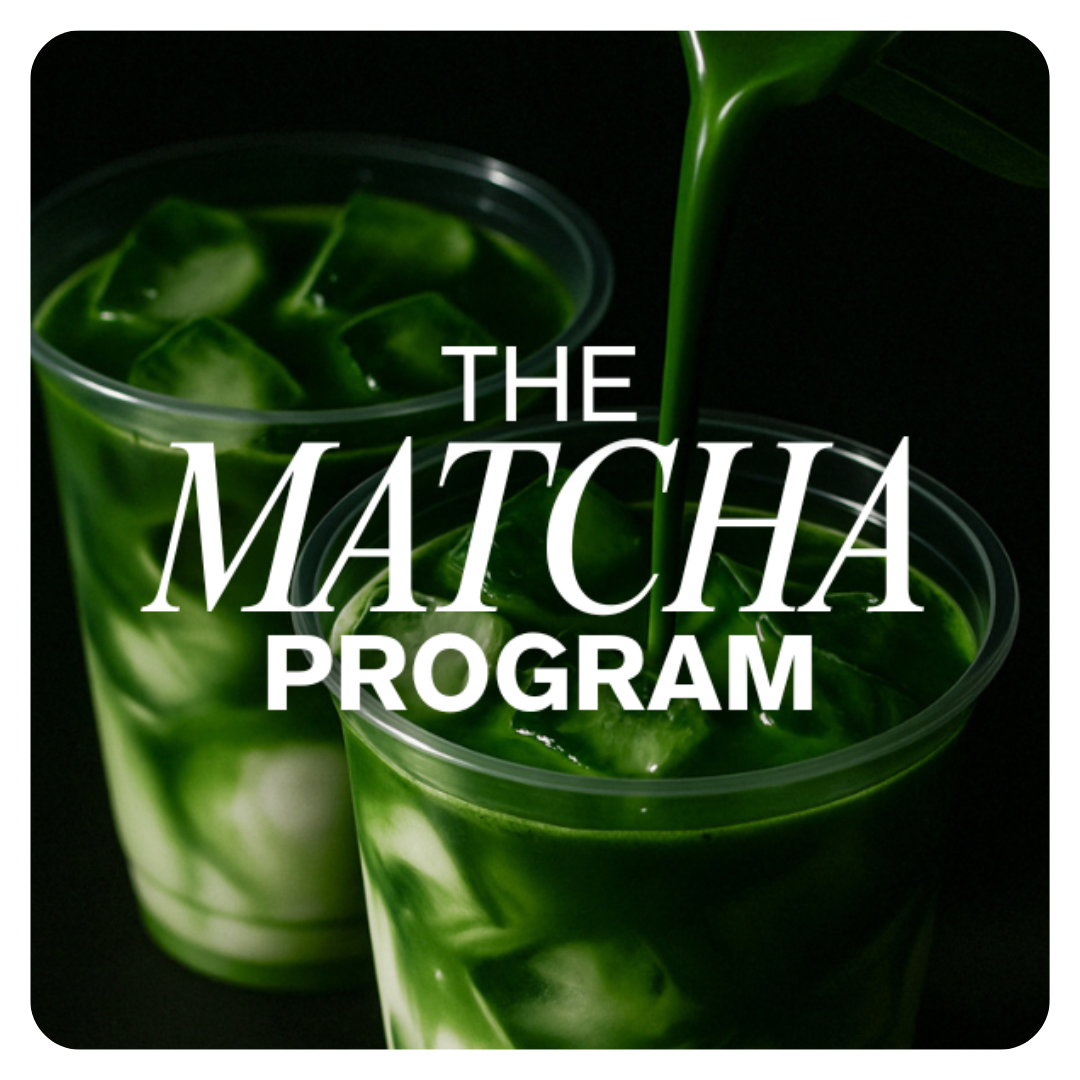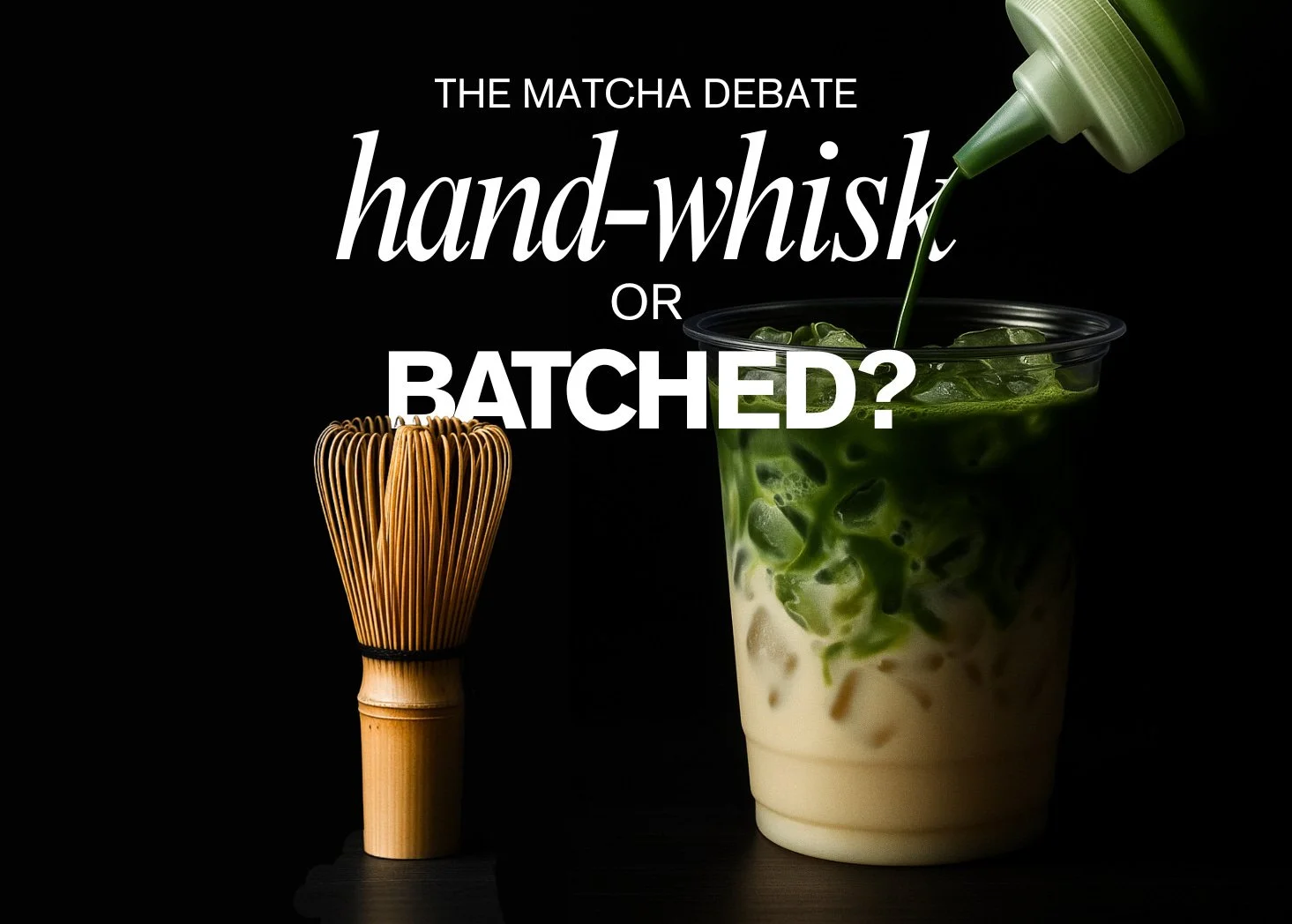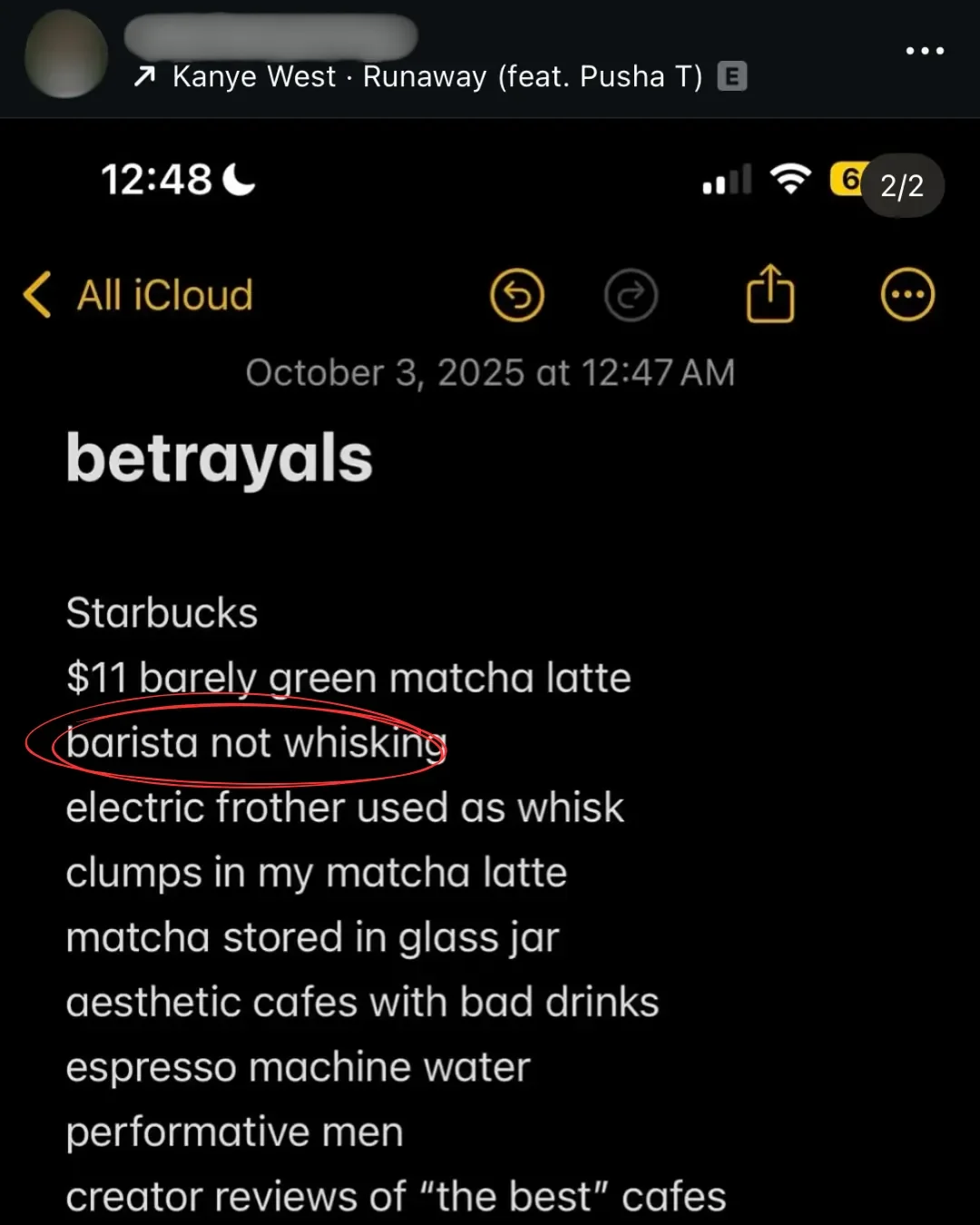Batching Matcha: Myths, Misconceptions, and Best Practices for Cafes and Pop-Ups
TL;DR for Operators
Because you’re busy 😉
Why batch: Faster workflow, consistent drinks, free up attention for customer interaction and storytelling. Especially vital for cafes managing coffee + matcha or pop-ups where every second = sales.
Core ratio: For concentrated prep, 2 g : 1 oz builds enough shear for full dispersion. Each ounce = a “matcha shot”—use like espresso in drink builds.
Water temps (°F):
≤104°F (≤40°C): sweet, smooth, stable
104–176°F (40–80°C): caffeine + complexity
158–176°F (70–80°C): catechins = bitterness
Hybrid: start cold, add a portion of 104–176°F water, then cool fast
Freshness = systems: Airtight, opaque containers; label prep times; chill when idle (ice bath or fridge).
Pop-ups: Shield from heat and light, keep on ice, make small frequent batches.
Equipment: Immersion blender, blender (low speed), fine-mesh strainer.
Team alignment: Every barista should know how much matcha is in each shot and be able to explain why batching reflects care, not shortcuts.
The Stigma Around “Batching”
Say “batching matcha” in a room of tea enthusiasts and you’ll get mixed reactions. Some view it as efficient and pragmatic, others as disrespectful to tradition. But batching is neither lazy nor “Americanized.” It’s a system, and like any system, its quality depends on design and execution.
Even in Japan, cafes and convenience counters use pre-mixed matcha for speed and consistency. The difference? They do it with intention—measured ratios, short prep cycles, and airtight storage.
Why Matcha Education for Operators Matters
So why does batching get such a bad rap in the U.S.? Because most of what’s written about matcha preparation is created for consumers, not operators. Recipes and tutorials assume you’re making one bowl at home, not 200 drinks in a six-hour rush. They highlight aesthetics—chasens, chawan sets, and frothy textures—but rarely address the operational realities of service: rush lines, milk steamers, bar flow, and multiple baristas sharing one matcha station while managing both coffee and matcha programs simultaneously.
Matcha education for operators is almost nonexistent to the general population. While a few matcha brands provide resources for their wholesale partners, most education still stops at the consumer level. It’s the missing link between what’s taught online and what actually happens behind the bar. However, the realities of service—rush lines, milk steamers, and multitasking baristas—require a different kind of guidance.
That’s why we started The Matcha Program.
Because matcha preparation has never been standardized in foodservice—and because the matcha market isn’t as mature as specialty coffee—the average cafe is left to figure it out on their own. And while batching can absolutely yield beautiful, consistent drinks, most cafes that batch aren’t implementing systems to maintain freshness.
What happens next is predictable:
A customer orders a matcha latte.
It’s made from a large, oxidized batch stored in a clear container.
The color looks dull, the taste is bitter or grassy.
The customer assumes, “Batching equals low quality.”
But that’s not the full story. When batching is done intentionally—with airtight storage, controlled prep cycles, and ratios that minimize oxidation—it results in matcha that’s smooth, vibrant, and balanced.
Batching isn’t the problem. The lack of systems and education is.
At The Matcha Program, our goal is to change that narrative and equip cafe operators, baristas, and pop-up founders with the knowledge to build matcha programs that reflect care, consistency, and quality—just like the rigor we see in specialty coffee.
Why Batching Is Ideal for Pop-Ups
Bella Cattani’s pop-up The Boba Shop is well-known for her batching systems.
For pop-up concepts, batching isn’t just efficient—it’s essential.
Unlike a fixed cafe environment, pop-ups operate under unpredictable conditions: fluctuating foot traffic, variable weather, and limited workspace. Every second spent whisking by hand is a second that slows service. In a model where total drinks sold = take-home income, speed directly impacts profitability.
When done right, batching allows operators to:
Maintain high drink output during rushes
Ensure consistency across multiple service windows
Reduce setup time and cleanup friction
Free up attention for customer interaction and storytelling
Hand-whisking during a pop-up might look romantic in theory, but in practice, it’s often inefficient—especially in windy or rainy conditions where open bowls and whisks quickly become a mess and create unsanitary working conditions. Pop-ups thrive on momentum and batching provides the foundation for smooth, streamlined service.
Protecting Batches in Outdoor Environments
Pop-ups also face another challenge: direct exposure to sunlight and warm temperatures. Without proper systems, heat accelerates oxidation, degrading color and flavor faster than in indoor settings.
If batching outdoors:
Use dark, airtight containers to block sunlight.
Keep batches on ice or in insulated coolers.
Prepare smaller, more frequent batches to reduce sitting time.
Avoid leaving matcha concentrate exposed to sunlight and in warm bottles for extended periods (heat + oxygen = dull, bitter matcha).
Even minor adjustments—like placing your batching container in an ice bath between orders—can dramatically extend the lifespan and vibrancy of your batch throughout a busy service day.
Ultimately, the best pop-up matcha programs mirror the efficiency of high-volume cafes but with tighter workflow design. The goal isn’t to cut corners; it’s to serve efficiently without compromising quality.
Myth #1: Batching = Lower Quality
Reality: Poorly designed batching systems lower quality, not batching itself.
When done properly, batching allows operators to maintain consistency, reduce waste, and minimize oxidation. It’s not a shortcut; it’s a deliberate system designed for speed without sacrificing flavor or vibrancy.
The key is batching smart, not batching big. Oversized containers and long holding times lead to dull color, bitter taste, and texture separation. Small, frequent batches are the sweet spot.
Myth #2: Hand-Whisking = Authentic
Reality: Technique matters more than tools.
A chasen (bamboo whisk) doesn’t guarantee authenticity if the water is too hot, the matcha has oxidized, or the whisking technique is inconsistent. Meanwhile, a well-calibrated batching setup with chilled water and proper ratios can yield a cleaner, smoother drink that still honors the essence of matcha.
Just like in coffee—hand-poured and batch-brewed can both be excellent—it’s about context and care.
Myth #3: Batching Ruins Freshness
Reality: Oxidation is the real culprit.
Matcha’s journey toward oxidation doesn’t start at the cafe—it starts at origin. The moment tencha leaves are stone milled and becomes matcha powder, it begins to react with air, light, and moisture. Producers in Japan slow this with airtight packaging, nitrogen flushing, and refrigerated storage.
Once that matcha reaches your cafe, you become the steward of maintaining its freshness. Matcha is far more delicate than espresso or coffee grounds, which means that improper storage or handling has a much greater impact on taste and color.
Whether whisking to order or batching for service, oxidation continues the moment the powder is opened. That’s why your storage protocols, not your method, determine quality.
Poorly sealed containers, exposure to light, or oversized transparent jars can dull color, flatten aroma, and produce bitterness—even with the highest-grade matcha. By contrast, batching done right—small quantities, cold water, airtight opaque containers, and short hold times—can slow oxidation and preserve the bright, smooth flavor customers expect.
In other words, batching doesn’t ruin freshness—neglecting freshness protocols does.
Designing a Smart Batching System
1️⃣ Choose the Right Ratio
Start with 1 g matcha : 1–2 oz water depending on your menu’s flavor intensity and intended use.
For a more concentrated base, 2 g : 1 oz produces enough shear (friction and turbulence) to fully disperse the powder, yielding a smooth, lump-free concentrate. Each 1 oz portion becomes a “matcha shot”—functionally equivalent to an espresso shot—and can be used in identical ratios for your drink builds:
1 shot (1 oz) → 8–10 oz latte
2 shots → 12–16 oz iced latte or signature drink
Crafting Your Batch Base
We recommend crafting your batch using only matcha and water. This keeps it versatile for guests with different milk or sweetness preferences.
However, if your operation is streamlined and you only offer one or two milk-based drinks, batching with your preferred milk can further speed up service.
This method is especially effective for pop-ups—take a cue from Bella at The Boba Shop, who crafts her batches with milk for efficient, high-volume service.
If you need more ratio inspiration, check out the comments section of this post, where operators and pros share their batching methods. Have fun—experiment, test, and adapt to your workflow.
Already Hand-Whisking? Reverse-Engineer Your System
If your cafe currently hand-whisks and you’re happy with your flavor balance, you don’t need to reinvent your recipe—you just need to scale it intelligently.
Start by determining your existing hand-whisk ratio (for example, 2 g matcha : 2 oz water). Then decide how much total concentrate you’d like your batch to yield.
For instance, if your current serving equals one drink and you want to batch enough for 100 drinks, you’d simply multiply your existing recipe by 100:
200 g matcha + 200 oz water
From there, fine-tune viscosity and intensity within the 1–2 oz range per gram. This preserves your current flavor profile while adapting it to a scalable, efficient system for service.
Once your base ratio feels balanced, reverse-engineer total volume for your expected output (for example, 50 drinks = 50 oz concentrate).
Pro Tip: When experimenting or adjusting shear and texture, always start small. Perfect flavor and consistency first, then scale to full production once your batch hits the desired taste and workflow sweet spot.
2️⃣ Use Cold or Controlled-Temperature Water
Water temperature influences sweetness, caffeine extraction, bitterness, and oxidation.
Flavor & chemistry (°F):
≤104°F (≤40°C): sweeter, smoother, stable; preserves amino acids (like L-theanine).
104–176°F (40–80°C): draws caffeine and complexity.
158–176°F (70–80°C): releases catechins → more bitterness.
~104°F (40°C): aromatics lift—great for aroma, not for holding.
Operator guidance:
For smooth, sweet flavor and max shelf life, use cold or room-temp water.
For more depth, start cold, add a small portion of 104–176°F water, then cool immediately (ice bath or fridge).
Avoid keeping batches warm more than 30 minutes—oxidation accelerates quickly.
Bottom line: Use cold for longevity; warm strategically for depth.
3️⃣ Prepare Small Batches Frequently
Matcha is delicate. Keep batches sized for 1–2 hours of service. Frequent rotation means fresher flavor and color. If you’re unable to prepare smaller batches throughout service, ensure your large batch stays refrigerated.
4️⃣ Store in Airtight, Opaque Containers
Light, air, and heat are matcha’s enemies.
Use stainless steel or dark glass bottles with airtight lids.
Label prep time and initials for accountability.
Avoid clear containers—they accelerate oxidation.
5️⃣ Refrigerate (or Chill) When Idle
If you have downtime, cool your batch.
High-volume cafes: fast turnover keeps it fresh.
Moderate or pop-up service: chill between rushes.
Two methods:
🧊 Ice Bath: keep containers in ice between orders.
❄️ Refrigerate: for idle periods over 30 minutes. Shake or stir gently before serving.
Condensation introduces moisture, so keep tools and lids completely dry.
Best Equipment for Batching at Scale
Consistency starts with the right setup:
Immersion Blender (Hand Blender): Excellent for small–medium batches. Creates strong shear without over-aerating.
Commercial Blender (Low Speed): Best for large volumes. Blend on low to prevent bubbles and oxidation.
Fine-Mesh Sieve / Tea Sifter: Use before mixing to break clumps, and again after blending to strain your batch—catching any remaining clumps before bottling.
Opaque or Dark Glass Containers: Preserve color and taste.
Scale + Timer: For precise ratio control and batching intervals.
Jigger or Bar Scale: Use to measure pours per drink for consistent matcha “shots.”
Best practices:
Matcha doesn’t dissolve—it suspends in water. Over time, it settles. Gently shake or stir before throughout service to re-incorporate the powder.
After blending, let batches rest about one minute for microbubbles to settle before bottling.
Every barista should know your standard ratios and “shot” equivalents. If a customer asks, “How many grams of matcha are in your latte?” the answer should be confident and consistent.
How Long Does a Batch Stay Fresh?
While properly stored batched matcha can technically hold for 2–3 days, we always recommend batching for same-day service and never carrying over to the next day.
Even under refrigeration, flavor and color degrade noticeably past the first 12–18 hours. For the best customer experience, build systems around daily prep cycles and frequent small batches.
How to Address Customer Concerns About Batching
Even when your systems are dialed in, guests may still equate hand-whisking with “authentic.” Your entire matcha program—station setup, containers, labeling, barista language—should tell a different story: one of intentional care.
Example talk track:
“We batch in small, airtight cycles to keep every drink consistent and fresh. It’s the same high-grade matcha we’d hand-whisk—we just protect color and flavor by keeping oxygen and heat low.”
It can feel like an uphill climb, especially when influencers label batching as “low quality.” But you have context. Your guests experience matcha in motion—in cafes, at pop-ups, and during rushes. Your role is to respect tradition and adapt it for modern service.
Batching done right is thoughtful, efficient, and a marker of expertise.
The Bottom Line
Batching isn’t the enemy of tradition—it’s the bridge between honoring matcha and running an efficient, modern cafe.
A well-designed system signals care, not convenience.
“Isn’t consistency and respect for the ingredient also a form of honoring it?”
Both batching and hand-whisking can coexist within a thoughtful program. Many cafes leverage both—batching for iced matcha lattes and hand-whisking for hot drinks or slow-bar service.
We write for high-volume cafes and pop-ups managing both coffee and matcha programs. Batching for scalability may feel like the antithesis of a teahouse or matcha bar centered around ceremony and mindful preparation—and that’s okay. We believe mindful prep matters, in the right context.
🧾 Takeaway for Operators
Start batching with iced drinks.
Document ratios, water temps, and prep intervals.
Use immersion blenders, fine-mesh sieves, and opaque containers.
Gently shake or mix before serving—matcha suspends, it doesn’t dissolve.
Measure pours per drink (jigger or scale).
Ensure every barista knows how many grams per shot and can confidently explain your program to guests.
Batching done right is one of the highest-ROI upgrades you can make: faster service, lower waste, better flavor, stronger guest trust.
📬 Coming Next:
“Matcha Station Design: What Your Setup Says About Your Program.”
Visual cues that signal care, quality, and intention.





